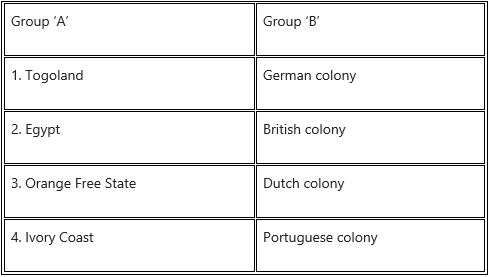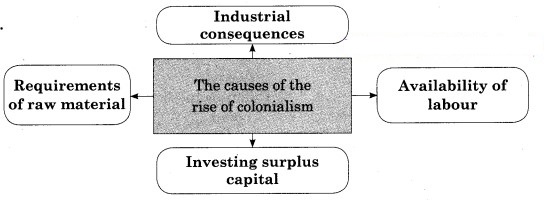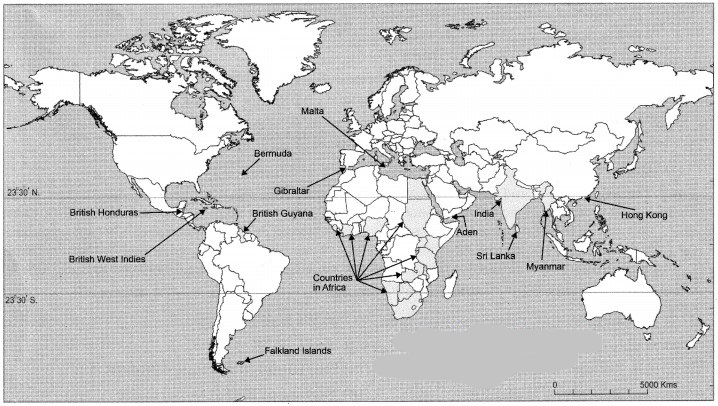Chapter 2 European Colonialism
1A. Choose the correct alternative and rewrite the statement.
Question 1.
‘Declaration of Independence was drafted by __________
(a) George Washington
(b) Thomas Jefferson
(c) Lord Amherst
(d) Lord Cornwallis
Answer:
(b) Thomas Jefferson
Question 2.
The second Anglo-Burmese war was fought during the times of __________
(a) Lord Amherst
(b) Lord Dufferin
(c) Lord Dalhousie
(d) Ashley Eden
Answer:
(c) Lord Dalhousie
1B. Find the incorrect pair from group ‘B’ and write the corrected one.
Question 1.

Answer:
Ivory Coast – French colony
2A. Write the names of historical places/persons/events.
Question 1.
The region from Florida to California on the southern coast of America was under the control of-
Answer:
Spain
Question 2.
The sea voyages for exploration were encouraged in the reign of-
Answer:
Queen Elizabeth I
2B. Choose the correct reason from those given below and complete the sentence.
Question 1.
The British wanted to gain control over Myanmar because __________
(a) they wanted to expand their empire
(b) it was very important to control the natural resources and the market in Myanmar
(c) they wanted to be at the forefront of the colonial competition amongst the European nations
(d) they wanted to teach a lesson to King Thibaw of Myanmar
Answer:
(b) it was very important to control the natural resources and the market in Myanmar
3. Complete the following concept map.
Question 1.
Answer:

4. Write short notes.
Question 1.
Nature of Colonialism.
Answer:
- Colonialism is the act of a developed nation occupying the land of a less developed, distant nation and establishing its rule on the occupied country. Europeans travelled all over the world with various intentions such as the urge for adventures, to earn a name, to discover unknown lands, to search for gold mines, etc.
- The Europeans established colonies wherever they went and in doing so there was a competition to gain economic, social, and political supremacy among the nations. Extreme nationalism, feeling of racial superiority, industrialization, aggressive approach, etc., are the factors that led to the growth of colonialism.
- Thus, Europeans went to America, Australia, and New Zealand. The Europeans also colonised Asia. However, the climate of Asia did not favour them. Favourable or unfavourable, Europeans disposed of the indigenous people in their own lands.
- The Europeans saw these colonies as potential marketplaces to sell their surplus goods which were accumulated as a result of mass production. The Europeans also needed additional sources that would provide ample raw material.
- In the latter half of the 19th century, England built a flourishing trade as a result of the industrial revolution.
Question 2.
American War of Independence.
Answer:
The colonies got into several battles with the British army even after gaining independence. The colonies finally at Saratoga got a decisive victory over the British army. This victory proved to be a turning point for the colonies as the French agreed to support them in their conflict against the British. Eventually, Spain also joined the conflicts in their struggle for independence.
On 7th October 1780, George Washington defeated the British army. On 19th October, British General Lord Cornwallis surrendered and America became independent. The American revolt for independence is also known as the ‘American Revolution’. America proved to the world that the subjects have a right to fight their rulers who deny them their natural rights.
5. Explain the following statements with reasons.
Question 1.
The industrial revolution gave momentum to colonialism.
Answer:
Colonialism was a result of the industrial revolution. Production increased enormously because of the new machines. However, the rate of local consumption was much less compared to the surplus rate of production. Hence, the immediate need of the Europeans was to find new markets for selling their products. It was also necessary that these markets be dependable and easy to dominate.
Question 2.
European nations established colonies in America.
Answer:
The stronger European nations dominated the weaker countries by establishing colonies there and pushed them to subjection. The lands of the original inhabitants in America were seized by the Europeans and were also massacred. The original inhabitants were forced into slavery. The Europeans discovered gold mines and the Spanish colonizers brought African slaves to work in sugarcane and tobacco fields. Farming and mining earned them enormous wealth. Essential raw materials were exported to Spain and the finished goods used to be imported for sale in the local markets for the colonies. The trade of gold and silver also earned huge profits for the king. Witnessing Spain’s prosperity England, Holland and France also began to establish colonies in America.
Questions and Answers
Try to do this. (Textbook Page No. 11)
Locate the following regions under British domination on the map: Gibraltar, Malta in the Mediterranean Sea; British Guyana, British Honduras, British West Indies, Bermuda and Falkland islands in the Western Hemisphere; Aden, Sri Lanka, Myanmar, Hongkong, India; also, the countries in Africa.
Answer:

Project (Textbook Page No. 18)
Question 1.
Collect information about the biodiversity and sources of minerals in the African continent.
Answer:
1. Meaning of Biodiversity:
Biodiversity consists of two words ‘Biological’ and ‘Diversity’. It refers to all the variety of life that can be found on earth (plants, animals, fungi, and microorganisms) as well as to the communities that they form and the habitats in which they live.
2. Biodiversity in Africa:
- Rich in biodiversity.
- Africa supports the earth’s largest assemblages of large mammals which roam freely in many countries.
- Africa is home to a rich and diverse animal, plant, and marine biodiversity that provide critical ecosystem services.
3. Minerals in Africa:
Africa is rich in mineral reserves and ranks first or second in quantity of world reserves of bauxite, cobalt, industrial diamond, phosphorite, platinum, etc.